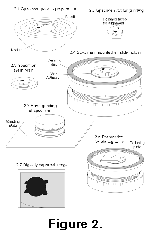METHODOLOGY FOR GRINDING AND DATA CAPTURE
Specimens selected for serial grinding (Figure
2.1) are first sawed to produce a small block with two faces perpendicular
to each other and to the direction of grinding, and as close to the specimen as
possible. These side faces are then polished to obtain the sharp edges at their
junction with the ground face (Figure 2.2).
 The
block is set within a resin cuboid or cylinder (Figure
2.3), that is then mounted with wax onto a Wirtz Buehler Slide Holder (Figure
2.4). Note that while Figure 2 illustrates
a grinding run performed on a single fossil, multiple specimens are normally
mounted within one resin block for greater efficiency. The slide-holder consists
of an inner metal cylinder that, by means of a screw thread, can be positioned
accurately to protrude any required distance beyond the plane of an outer hard
ceramic disc. This enables a fixed thickness to be ground away before the
ceramic comes into contact with the grinding plate and prevents any further
removal of material.
The
block is set within a resin cuboid or cylinder (Figure
2.3), that is then mounted with wax onto a Wirtz Buehler Slide Holder (Figure
2.4). Note that while Figure 2 illustrates
a grinding run performed on a single fossil, multiple specimens are normally
mounted within one resin block for greater efficiency. The slide-holder consists
of an inner metal cylinder that, by means of a screw thread, can be positioned
accurately to protrude any required distance beyond the plane of an outer hard
ceramic disc. This enables a fixed thickness to be ground away before the
ceramic comes into contact with the grinding plate and prevents any further
removal of material.
Specimens are ground manually on a glass plate (Figure 2.5) with 600 grade carborundum powder and water to remove thicknesses of approximately 30-50 Ám at a time. After each thickness is removed, the slide holder is inverted and placed on its base. The surface is then washed and polished for a few seconds with a small flat plate coated in fine-grade aluminium oxide powder and water (Figure 2.6). This final polishing improves image quality without removing any appreciable thickness of sample. The surface is then washed again, and the slide-holder placed under a Leica MZ8 binocular microscope. An image of each specimen and alignment edges (Figure 2.7) is then captured by means of a digital camera attached to the microscope operating at 1000 by 800 pixel resolution in 24-bit colour. The image is checked for quality prior to filing as part of a sequential set. All images for a grinding run are taken at the same magnification, with the same camera settings, and under consistent lighting conditions; only the focus is re-adjusted for each image. The grinding process is then repeated for as many iterations as required. The time taken per image depends on how many specimens are mounted at once for a grinding run, but on average it takes six minutes to grind a 30 Ám interval and one minute to photograph each specimen. After completion of a grinding run each dataset is prepared for use by registration of the images (see Appendix 1, section 1).